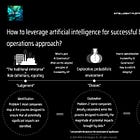📮 Maildrop 06.02.24: The important task of adopting an inclusive AI evaluation system
The things to know about AI | Tools for the next generation of enterprises in the AI era
Reading time: 5 minutes
Artificial intelligence and robotics are increasingly changing the type of tasks performed in many sectors, increasing the speed and depth of change and the tendency of specific jobs to be automated.
Automation is not a new phenomenon, but with the paradigm shift happening, we need new processes of measuring and assessing how well an AI systems perform.
Implementing strategies for making AI performance evaluations more inclusive can provide business leaders with benefits such as:
improved accuracy and performance,
reliable metrics for decision-making,
mitigation of biases and risks,
enhanced transparency and trust,
diverse perspectives for robust assessments,
valuable user insights for continuous improvement,
alignment with ethical standards,
proactive bias identification,
and fostering innovation through collaboration.
→ First and foremost, you should start with this if you're looking to build an AI project.
What is AI performance evaluation?
Artificial intelligence performance evaluation is the processes of measuring and assessing how well AI systems perform. The intended tasks and functions, and how the system compares to other systems or human standards.
It can be done for different purposes, such as testing, debugging, improving, validating, or benchmarking AI systems.
It can also involve different criteria, such as accuracy, speed, reliability, usability, or ethics.
Depending on the purpose and the criteria, Artificial intelligence performance evaluation can use different methods, such as experiments, surveys, interviews, observations, or audits.
↓↓ More below ↓↓




